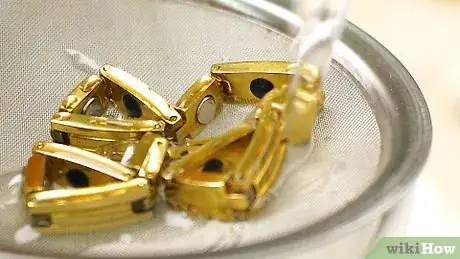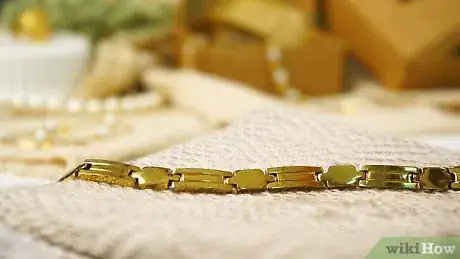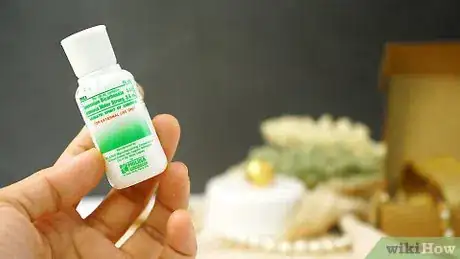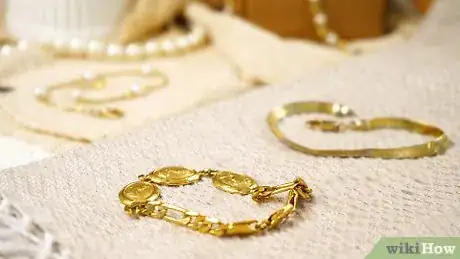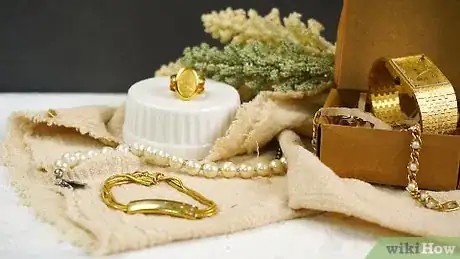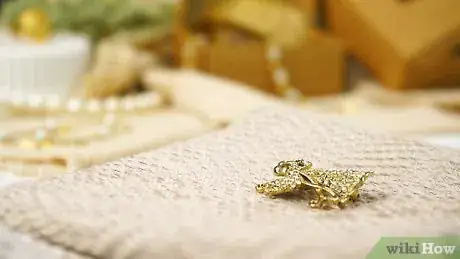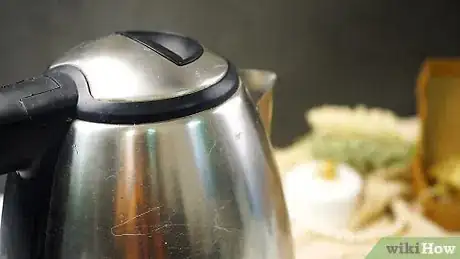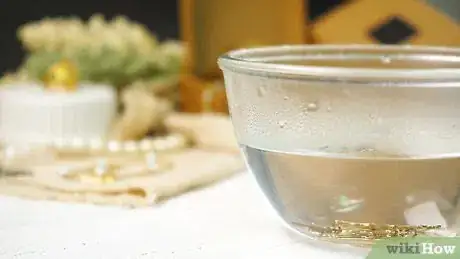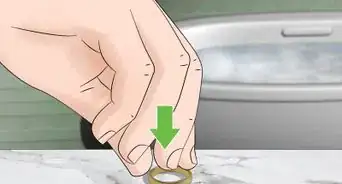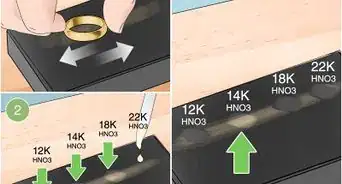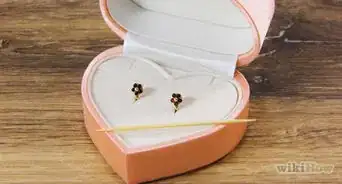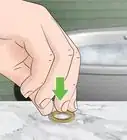This article was co-authored by Kennon Young. Kennon Young is a Master Gemologist Appraiser and the Owner of Vermont Gemological Laboratory in Burlington, Vermont. With over 20 years of experience in the industry, Kennon and his team specialize in handmade engagement rings, wedding bands, and custom jewelry. He attended the Revere Academy of Jewelry Arts, the Gemological Institute of America, and the Rhode Island School of Design Extension. He is a Jewelers of America (JA) Certified Bench Jeweler Technician and received the highest credential in the jewelry appraisal industry, the ASA Master Gemologist Appraiser, in 2016.
There are 10 references cited in this article, which can be found at the bottom of the page.
wikiHow marks an article as reader-approved once it receives enough positive feedback. This article has 23 testimonials from our readers, earning it our reader-approved status.
This article has been viewed 2,912,894 times.
If your gold jewelry is looking a little lackluster, don't worry — a thorough cleaning will get it looking brand-new again! You don't even need to use expensive jewelry cleaners to get your gold sparkling and shining. Some simple household products you can find right at home will do the trick.
Steps
Cleaning Jewelry with Dish Soap
-
1Put a few drops of liquid dish detergent in a bowl of lukewarm (not hot) water. Mix gently. Though ordinary tap water will work fine, for even better results, you can use sodium-free seltzer water or club soda. The carbonation in these liquids can help loosen accumulated dirt and debris.[1]
- Don't use hot or boiling water, especially if your jewelry contains fragile precious stones. Some precious stones, like opals, can crack if subjected to rapid and drastic temperature changes. Similarly, don't use freezing cold water because the grime will contract and get tougher.[2]
- This method can also be used to polish gold filled jewelry.
-
2Soak the gold jewelry in the solution. Allow the jewelry to sit in the water for about 15-30 minutes. As it soaks, warm soapy water will work its way into the cracks and crevices, loosening hard-to-reach buildups of dirt.Advertisement
-
3Gently scrub the jewelry with a soft-bristled toothbrush. Scrub each piece of jewelry individually, paying special attention to nooks and crannies where dirt may be hidden. Use a very soft brush - the softer the better. Stiff bristles can scratch the surface of your jewelry. If your jewelry is gold-plated (as opposed to solid gold), especially, stiff bristles can even remove the gold layer entirely! However, if there is any crevice that is not cleaning up, take a Q-Tip and rub it softly along the fissure.[3]
- Special brushes designed for this purpose are best, but most small, soft brushes (like, for instance, eyebrow brushes) will also work.
-
4Rinse each piece in warm running water. A good rinsing will help remove lingering dirt that's been loosened by the action of your brush. Again, make sure the water isn't hot , especially if your jewelry contains fragile stones. Don't let the water flow in a very powerful stream either as it pours a lot of strength on the jewel.
- If you're rinsing your jewelry in a sink, plug or cover the drain so that you don't accidentally lose your jewelry if it slips out of your hands. Alternatively, rinse your jewelry in a pasta strainer or metal coffee filter.
-
5Blot dry with a soft cloth. Then, let the jewelry sit out on a towel to air dry completely before wearing it again. If your jewelry is still wet, wearing it can trap moisture against your skin, leading to minor skin irritation.
Cleaning Jewelry with Ammonia
-
1Know when to clean with ammonia. Ammonia is a powerful cleaner, but, chemically, it can be somewhat caustic. Avoid doing using ammonia to clean gold jewelry too often to prevent wear on your jewelry - ammonia is a good candidate for occasional (but not frequent) "deep cleans."
- Ammonia can damage certain materials often used in jewelry. Don't use ammonia when cleaning gold jewelry pieces that contain platinum or pearls.
-
2
-
3Soak the jewelry in the mixture for no more than one minute. Don't let jewelry sit in the ammonia mixture for too long - as a strong base, ammonia can be slightly corrosive.
- To quickly remove all of the jewelry at once, use a kitchen strainer like you might use when cooking pasta. Either fish the jewelry out with a hand-held strainer or upend the bowl into a larger strainer in the sink.
-
4Rinse the jewelry thoroughly under running water. Plug or cover the drain of the sink to prevent losing any precious jewelry that slips out of your hand. Alternatively, simply use the strainer you used to get your jewelry out of the ammonia.
-
5Gently dry the jewelry with a soft polishing cloth. Allow jewelry to air dry on a towel completely before wearing it.
Cleaning Jewelry with Glued-In Gemstones
-
1Know which types of jewelry should be kept dry. Pieces of jewelry with gemstones that are glued into their setting (like many earrings) should not be submerged in water. Warm water can loosen the glue, which can cause your gemstones to fall out, especially when subjected to a thorough brushing.[5] For these types of jewelry, use a special cleaning method that avoids total submersion in water.
-
2Wipe the jewelry with a wet, soapy cloth. Make a small quantity of dish soap solution as in Method One. Dip a soft, delicate towel in the solution and gently scrub your jewelry.
-
3"Rinse" the jewelry with a cloth dampened with plain water. Gently dab a wet cloth onto the jewelry, taking care to soak up any leftover soap suds.
-
4Lay or hang the pieces upside down after cleaning. Allow your jewelry to dry in this way. By letting your jewelry dry upside down, you allow any remaining moisture to drip out, ensuring it won't soak into the setting.
Using Boiling Water
-
1Know when boiling is appropriate. Gold itself can be boiled with no problems. However, boiling delicate gemstones (like opals, pearls, coral, and moonstones) can cause them to crack or become damaged - especially if the jewelry is cold before boiling. Boiling is also a bad idea for jewelry with glued-in gemstones, as it can loosen the glue. However, if you're looking to clean heavily soiled jewelry made entirely out of gold or gold jewelry that contains "strong" gemstones (like diamonds), boiling is a great choice.
-
2Bring water to a boil. You don't need to boil much water - just enough to submerge all of the jewelry in. As you're waiting for the water to boil, set your gold jewelry in a sturdy bowl or another vessel that won't be damaged by boiling water. Pyrex or metal cooking bowls/dishes are good choices.
- Arrange jewelry in the dish or bowl so that no piece of jewelry is covering up another piece - water should be able to reach every piece of jewelry.
-
3Carefully pour the water over your jewelry. Be very careful not to spill or splash by pouring too rapidly - boiling water can cause serious burns. When all of the jewelry is completely submerged, you've added enough water.
-
4Wait for the water to cool. When you can comfortably put your hands in the water, you can remove the jewelry. Follow a good boiling by scrubbing each piece of jewelry with a soft brush, then dabbing it dry with a soft towel and allowing it to sit and air-dry completely.
- Don't be afraid if the water appears dirty - this is good! As boiling water loosens the dirt, wax, grime, etc. that's built up on your jewelry, it may float to the surface of the water. The dirtier your water looks, the more dirt you've removed from your jewelry!
Our Most Loved Articles & Quizzes
Expert Q&A
Did you know you can get premium answers for this article?
Unlock premium answers by supporting wikiHow
-
QuestionCan you polish gold jewelry yourself?
 Kennon YoungKennon Young is a Master Gemologist Appraiser and the Owner of Vermont Gemological Laboratory in Burlington, Vermont. With over 20 years of experience in the industry, Kennon and his team specialize in handmade engagement rings, wedding bands, and custom jewelry. He attended the Revere Academy of Jewelry Arts, the Gemological Institute of America, and the Rhode Island School of Design Extension. He is a Jewelers of America (JA) Certified Bench Jeweler Technician and received the highest credential in the jewelry appraisal industry, the ASA Master Gemologist Appraiser, in 2016.
Kennon YoungKennon Young is a Master Gemologist Appraiser and the Owner of Vermont Gemological Laboratory in Burlington, Vermont. With over 20 years of experience in the industry, Kennon and his team specialize in handmade engagement rings, wedding bands, and custom jewelry. He attended the Revere Academy of Jewelry Arts, the Gemological Institute of America, and the Rhode Island School of Design Extension. He is a Jewelers of America (JA) Certified Bench Jeweler Technician and received the highest credential in the jewelry appraisal industry, the ASA Master Gemologist Appraiser, in 2016.
Master Gemologist Appraiser
-
QuestionHow do you clean tarnished gold?
 Kennon YoungKennon Young is a Master Gemologist Appraiser and the Owner of Vermont Gemological Laboratory in Burlington, Vermont. With over 20 years of experience in the industry, Kennon and his team specialize in handmade engagement rings, wedding bands, and custom jewelry. He attended the Revere Academy of Jewelry Arts, the Gemological Institute of America, and the Rhode Island School of Design Extension. He is a Jewelers of America (JA) Certified Bench Jeweler Technician and received the highest credential in the jewelry appraisal industry, the ASA Master Gemologist Appraiser, in 2016.
Kennon YoungKennon Young is a Master Gemologist Appraiser and the Owner of Vermont Gemological Laboratory in Burlington, Vermont. With over 20 years of experience in the industry, Kennon and his team specialize in handmade engagement rings, wedding bands, and custom jewelry. He attended the Revere Academy of Jewelry Arts, the Gemological Institute of America, and the Rhode Island School of Design Extension. He is a Jewelers of America (JA) Certified Bench Jeweler Technician and received the highest credential in the jewelry appraisal industry, the ASA Master Gemologist Appraiser, in 2016.
Master Gemologist Appraiser
Warnings
- Opal stones are very delicate. Never use chemicals, abrasives, toothpaste or ultrasonic cleaners, instead gently wipe with facial tissue or piece of silk.⧼thumbs_response⧽
- If you have a gold ring with a diamond or any kind of gemstone, make sure that its prongs are not damaged and the stone is safe from falling out.⧼thumbs_response⧽
- Don't use bleach...In fact, don't expose the jewelry to any kind of chlorine, as it can permanently discolor it.[8]⧼thumbs_response⧽
- Toothpaste can scratch gold jewelry and gemstones, so it's generally best to avoid using it for home cleaning.[9] [10]⧼thumbs_response⧽
References
- ↑ https://www.goodhousekeeping.com/home/cleaning/tips/a25736/how-to-clean-jewelry/
- ↑ http://www.gemsociety.org/article/opal-jewelry-and-gemstone-information/
- ↑ https://www.womansday.com/style/fashion/how-to/a4730/how-to-clean-your-jewelry-at-home-103103/
- ↑ https://www.onecklace.com/tips/how-to-clean-gold-jewelry/
- ↑ https://www.today.com/style/how-clean-your-sterling-silver-gold-jewelry-home-t128503
- ↑ http://www.jic.org/?page=how-to-clean
- ↑ Kennon Young. Certified Jeweler. Expert Interview. 11 September 2019.
- ↑ https://info.jewelersmutual.com/the-jewelry-box/how-to-clean-gold-jewelry-the-right-way
- ↑ https://connoisseurs.com/jewelry_care_tips/toothpaste-shouldnt-use-clean-your-jewelry/
About This Article
To clean your gold jewelry, start by mixing a few drops of liquid dish soap into a bowl of lukewarm water. Then, put your gold jewelry in the water and let it sit for 30 minutes. After 30 minutes, take out your jewelry and gently scrub it with a clean soft-bristled toothbrush. Finish by rinsing your jewelry with warm water and then blotting it dry with a clean cloth. To learn how to clean your gold jewelry with toothpaste, boiling water, or ammonia, keep reading!
